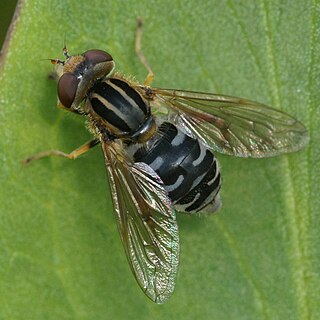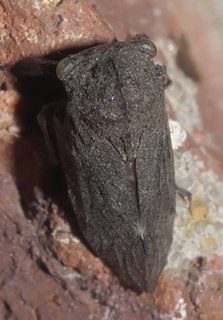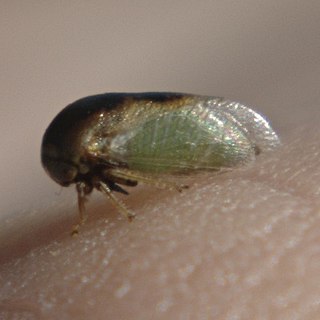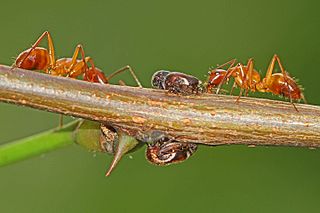
Bubalus is a genus of bovines that was first described by Charles Hamilton Smith in 1827. This genus comprises the following living species:

A leafhopper is the common name for any species from the family Cicadellidae. These minute insects, colloquially known as hoppers, are plant feeders that suck plant sap from grass, shrubs, or trees. Their hind legs are modified for jumping, and are covered with hairs that facilitate the spreading of a secretion over their bodies that acts as a water repellent and carrier of pheromones. They undergo a partial metamorphosis, and have various host associations, varying from very generalized to very specific. Some species have a cosmopolitan distribution, or occur throughout the temperate and tropical regions. Some are pests or vectors of plant viruses and phytoplasmas. The family is distributed all over the world, and constitutes the second-largest hemipteran family, with at least 20,000 described species.

The Auchenorrhyncha suborder of the Hemiptera contains most of the familiar members of what was called the Homoptera – groups such as cicadas, leafhoppers, treehoppers, planthoppers, and spittlebugs. The aphids and scale insects are the other well-known "Homoptera", and they are in the suborder Sternorrhyncha. Lesser-known insects largely regarded as Homoptera are the Coleorrhyncha. However, the taxonomic status of the Hemiptera and Homoptera is currently under investigation and discussion. See Heteroptera and Prosorrhyncha for more information.

The superfamily Membracoidea are sap-sucking true-bugs that includes two of the largest families within what used to be called the "Homoptera"; the leafhoppers (Cicadellidae) and the treehoppers (Membracidae). The other families in this group are quite small, and have, at various points, generally been included as members within other families, though they are all presently considered to be valid, monophyletic groups. The odd, relictual family Myerslopiidae is one of the most recently described of all Hemipteran families.

Batumi is a city on the Black Sea coast and capital of Adjara, an autonomous republic in southwest Georgia. The city was under Russian rule at the beginning of World War I, but local unrest led to Turkey entering the city in April 1918, followed by the British in December, who stayed until July 1920.

The buffalo treehopper is a species of treehopper belonging to the subfamily Membracinae. It is also sometimes classified as Ceresa bisonia.

Lejops is a genus of hoverflies. The majority of the species are found in the Americas and Australia, with the exception of Lejops vittatus which is found in Europe and Asia.

Aetalionidae are a family of plant-hoppers or tree-hoppers in the superfamily Membracoidea. Aetalionidae are somewhat like Membracidae in that they have one to three rows of short spines on the hind tibia but differ in having the front femur fused to the trochanter and the scutellum is completely exposed. The females have finger-like protrusions on the genital capsule. The family is mostly Neotropical. The subfamily Biturritiinae is Neotropical while the subfamily Aetalioninae has a Neotropical genus Aetalion and the sole Old World representative genus Darthula with a single species Darthula hardwickii.
Frank G. Zalom is an American entomologist at University of California, Davis and an Elected Fellow of the American Association for the Advancement of Science.

Microcentrus is a genus of treehoppers in the family Membracidae. There are about 10 described species in Microcentrus.

Micrutalis is a genus of treehoppers in the family Membracidae. There are at least 30 described species in Micrutalis.

Smiliinae is a subfamily of treehoppers in the family Membracidae. These are bugs and include about 100 genera in 10 tribes.

Telamona is a genus of treehoppers in the family Membracidae. There are at least 30 described species in Telamona.

Thelia is a genus of treehoppers in the family Membracidae. There are at least two described species in Thelia.

Tylopelta is a genus of treehoppers in the family Membracidae. There are at least four described species in Tylopelta.

Vanduzea is a genus of treehoppers in the family Membracidae. There are about 12 described species in Vanduzea.

Bocydium is a genus of insects in the treehopper family, Membracidae. A 1999 classification identified 14 species in the genus, distributed around the Neotropics.

Ignaz Matausch was an Austrian-American artist and entomologist known for his models of insects and other invertebrates at the American Museum of Natural History. Born in Budweis, he emigrated to the United States in 1892 and resided in Cleveland, Ohio, until 1904, when he became a member of the modeling staff of the American Museum. He was known for his realistic large-scale models including the flea, house fly, and spider. As an entomologist he focused on treehoppers (Membracidae), authoring eight papers on their biology.



















